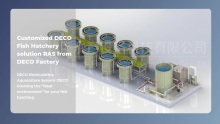DECO UV Sterilizer
Ultraviolet Ray Disinfection (UV Disinfection)
UV disinfection is used widely in fisheries. The UV disinfection unit is equipped with an ultraviolet ray lamp that disinfects by the following mechanism. An ultraviolet ray of a certain wave length damages the nuclei in cells of microorganisms in the water, resulting in the death of the microorganisms. Of the various commercially available UV lamps, those with a wavelength of 254 nm are the most effective for disinfection, as the wavelength of maximum UV absorption for DNA is near 260nm.
This method is safe and simple; however, treatments that are too long produce excessive amount of oxidants in the treated water. Therefore, it is necessary to monitor for the negative effects of oxidants. UV disinfection of water containing large amounts of suspended matter is often incomplete because the suspended matter creates shadows. In the case of red sea bream seed production in CRAS, UV kills 99.9% of the bacteria in the water. The development of a UV-light-emitting diode (LED) is progressing. When the problems regarding the production cost and life span are solved, UV-LED will be widely used in this field.
 Audited supplier
Audited supplierUltraviolet Ray Disinfection (UV Disinfection)
UV disinfection is used widely in fisheries. The UV disinfection unit is equipped with an ultraviolet ray lamp that disinfects by the following mechanism. An ultraviolet ray of a certain wave length damages the nuclei in cells of microorganisms in the water, resulting in the death of the microorganisms. Of the various commercially available UV lamps, those with a wavelength of 254 nm are the most effective for disinfection, as the wavelength of maximum UV absorption for DNA is near 260nm.
This method is safe and simple; however, treatments that are too long produce excessive amount of oxidants in the treated water. Therefore, it is necessary to monitor for the negative effects of oxidants. UV disinfection of water containing large amounts of suspended matter is often incomplete because the suspended matter creates shadows. In the case of red sea bream seed production in CRAS, UV kills 99.9% of the bacteria in the water. The development of a UV-light-emitting diode (LED) is progressing. When the problems regarding the production cost and life span are solved, UV-LED will be widely used in this field.
 Audited supplier
Audited supplier
Customized DECO Fish Hatchery solution RAS from DECO Factory

Customized DECO Fish Hatchery solution RAS from DECO Factory

The Production DECO ATK Sand Filter and Related Water Treatment Equipment

DECO RAS - A Glance of Our Projects

DECO RAS - We Take Care of the Water for Your Fish Business

DECO UV Sterilizer

Penaeus Vannamei Culturing Farm featuring DECO RAS

DECO RAS Application in JB Inland Fish Farm, Jiangxi

DECO RAS








